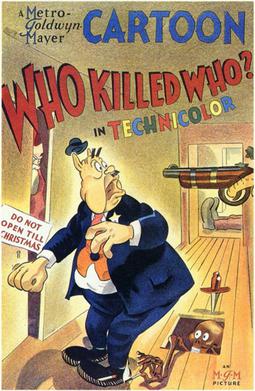
Melvin Jerome Blanc was an American voice actor and radio personality whose career spanned over 60 years. During the Golden Age of Radio, he provided character voices and vocal sound effects for comedy radio programs, including those of Jack Benny, Abbott and Costello, Burns and Allen, The Great Gildersleeve, Judy Canova and his own short-lived sitcom.

Winstead Sheffield "Doodles" Weaver was an American character actor, comedian, and musician.

Frederick Bean "Tex" Avery was an American animator, cartoonist, director, and voice actor. He was known for directing and producing animated cartoons during the golden age of American animation. His most significant work was for the Warner Bros. and Metro-Goldwyn-Mayer studios, where he was crucial in the creation and evolution of famous animated characters such as Bugs Bunny, Daffy Duck, Porky Pig, Elmer Fudd, Droopy, Screwy Squirrel, The Wolf, Red Hot Riding Hood, and George and Junior.

James Francis Durante was an American comedian, actor, singer, and pianist. His distinctive gravelly speech, Lower East Side accent, comic language-butchery, jazz-influenced songs, and prominent nose helped make him one of the United States' most familiar and popular personalities of the 1920s through the 1970s. He often referred to his nose as the schnozzola, and the word became his nickname.

Abbott and Costello were an American comedy duo composed of comedians Bud Abbott and Lou Costello, whose work in radio, film, and television made them the most popular comedy team of the 1940s and 1950s, and the highest-paid entertainers in the world during the Second World War. Their patter routine "Who's on First?" is considered one of the greatest comedy routines of all time, a version of which appears in their 1945 film The Naughty Nineties.

Hubert Prior Vallée, known professionally as Rudy Vallée, was an American singer, saxophonist, bandleader, actor, and entertainer. He was the first male singer to rise from local radio broadcasts in New York City to national popularity as a "crooner".

Amos 'n' Andy was an American radio sitcom about black characters, initially set in Chicago then later in the Harlem section of New York City. While the show had a brief life on 1950s television with black actors, the 1928 to 1960 radio show was created, written and voiced by two white actors, Freeman Gosden and Charles Correll, who played Amos Jones (Gosden) and Andrew Hogg Brown (Correll), as well as incidental characters. On television from 1951–1953, black actors took over the majority of the roles; white characters were infrequent.

Duffy's Tavern is an American radio sitcom that ran for a decade on several networks, concluding with the December 28, 1951, broadcast.

Joe Penner was an American vaudeville, radio, and film comedian.

The Life of Riley is an American radio situation comedy series of the 1940s that was adapted into a 1949 feature film, as well as two different television series, and a comic book.

William H. Thompson, known professionally as Bill Thompson, was an American radio personality and voice actor, whose career stretched from the 1930s until his death. He was a featured comedian playing multiple roles on the Fibber McGee and Molly radio series, and was the voice of Droopy in most of the Metro-Goldwyn-Mayer cartoon studio theatrical cartoons from 1943 to 1958.

Connie Russell was an American singer and movie actress. Born in New York City, she appeared in seven films from the 1930s through the 1950s. She was far better known as a singer than as an actress, as her singing career was quite extensive.
Jack Douglas was an American comedy writer who wrote for radio and television while additionally writing a series of humor books.

Who Killed Who? is a 1943 Metro-Goldwyn-Mayer film noir animated short directed by Tex Avery. The cartoon is a parody of whodunit stories and employs many clichés of the genre for humor; for example, the score is performed not by the MGM orchestra but by a solo organ, imitating the style of many radio dramas of the era.

Albert Pearce was an American comedian, singer and banjo player who was a popular personality on several radio networks from 1928 to 1947.

The Fleischmann's Yeast Hour was a pioneering musical variety radio program broadcast on NBC from 1929 to 1936, when it became The Royal Gelatin Hour, continuing until 1939. This program was sponsored by Fleischmann’s Yeast, a popular brand of yeast.

The Shooting of Dan McGoo is a cartoon directed by Tex Avery and starring Frank Graham as the Wolf. Both Bill Thompson and Avery himself voiced the lead character Droopy. Sara Berner did the speaking voice of Lou, while her singing was provided by Imogene Lynn. The cartoon was edited for a 1951 re-release. It is a loose remake of Avery's 1939 cartoon for Warner Bros., Dangerous Dan McFoo.
The Raleigh Cigarette Program was an American old-time radio comedy program that starred comedian Red Skelton.

The Abbott and Costello Show is a comedy program from the era of old-time radio in the United States. It was broadcast first on NBC and later on ABC, beginning on July 3, 1940 and ending on June 9, 1949.

Patrick Joseph McGeehan was an American actor.


















